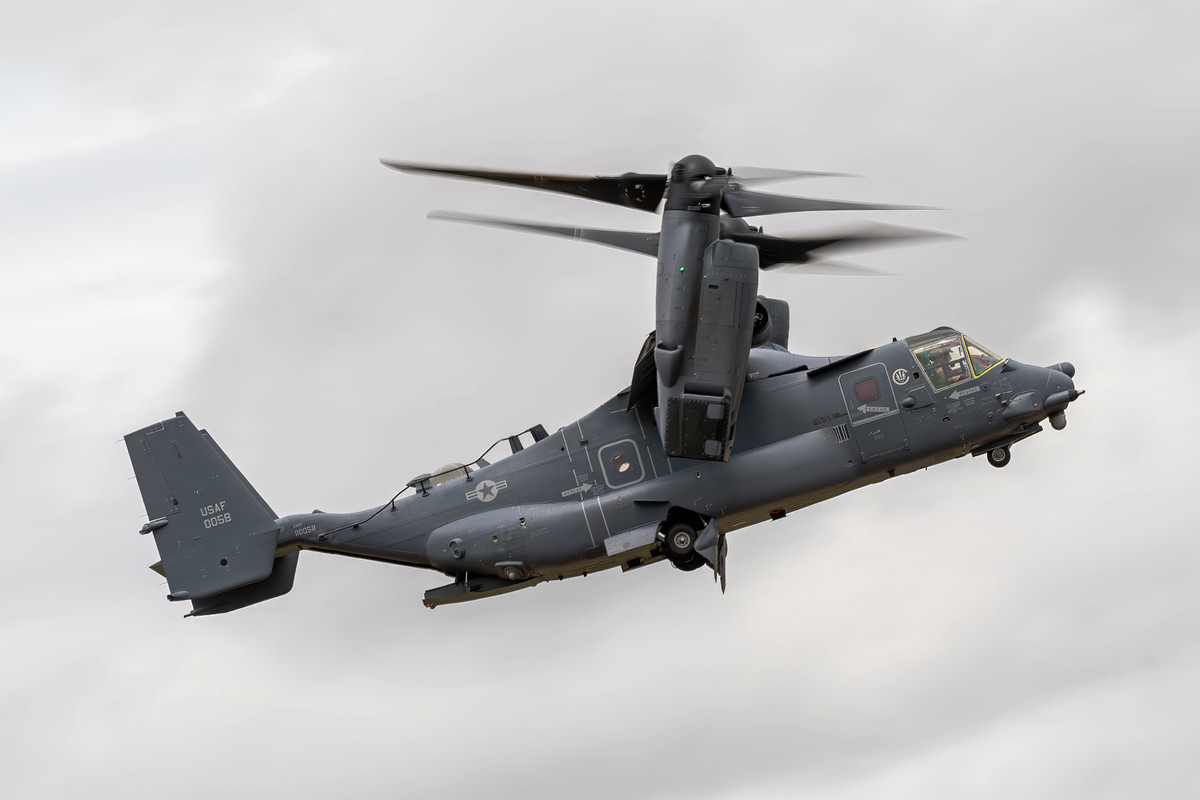
United States Air Force CV-22B Osprey Demo
CV-22B Osprey Demo
The USAF CV-22B Osprey demonstration is performed by pilots from the 7th Special Operations Squadron, part of the 352nd Special Operations Wing, stationed at RAF Mildenhall in Suffolk, England. Unlike traditional airshow teams, this is not a formal display unit but rather a group of operational aircrew showcasing the aircraft’s capabilities during select events. The CV-22B, a tiltrotor aircraft designed for special operations, blends the vertical lift of a helicopter with the speed and range of a fixed-wing plane, making it a standout feature at airshows.
During the demo, the crew executes a series of maneuvers that emphasize the Osprey’s unique design and performance. Spectators can expect to see high-speed passes demonstrating its turboprop speed, followed by low-speed flight and precise hovering that highlight its rotorcraft roots. The aircraft’s ability to transition seamlessly between configurations and perform short takeoffs and landings is a key focus, reflecting its real-world role in rapid troop insertion and extraction missions for special forces.
Though not a regular fixture on the airshow circuit, the CV-22B demo is a rare treat for aviation fans, often appearing at prestigious events like the Royal International Air Tattoo, known as the world’s largest military airshow. These performances offer a glimpse into the operational prowess of the 352nd Special Operations Wing and the technological marvel that is the Osprey. The display underscores the aircraft’s critical role in modern military operations, captivating audiences with its blend of power, precision, and versatility.
About the CV-22B Osprey
The CV-22B Osprey is a tiltrotor aircraft developed by Bell Helicopter and Boeing as part of the broader V-22 Osprey program, initiated by the United States Department of Defense in 1981 under the Joint-service Vertical take-off/landing Experimental (JVX) program. The concept aimed to combine the vertical takeoff, hover, and landing capabilities of a helicopter with the long-range, high-speed cruise performance of a turboprop aircraft. A development contract was awarded to the Bell-Boeing partnership in 1983, and the first V-22 prototype took flight on March 19, 1989, in helicopter mode, followed by its first fixed-wing flight on September 14, 1989. The CV-22B variant, tailored for the U.S. Air Force, emerged from this foundation, incorporating specialized avionics and systems to meet the needs of special operations missions.
Development of the V-22 faced significant technical and budgetary challenges, leading to a prolonged testing and refinement period. After initial prototypes underwent extensive flight testing, the program saw a redesign in the early 1990s to improve performance and reduce costs, resulting in the V-22B model. The CV-22B, specifically designed for the U.S. Air Force Special Operations Command (AFSOC), began taking shape with deliveries of test aircraft to Edwards Air Force Base, California, in September 2000. The aircraft entered operational service with the Air Force in 2009, following years of crew training and evaluations that began in 2006 at Kirtland Air Force Base, New Mexico. Its unique tiltrotor design allows it to transition from vertical flight to high-speed forward flight in just 12 seconds, offering unmatched versatility.
The CV-22B has since become a cornerstone of U.S. military aviation, with production continuing under a multiyear procurement plan. As of 2025, the Air Force has integrated the aircraft into its fleet, with a total of 54 CV-22Bs planned for delivery. The aircraft’s ability to operate in diverse environments—thanks to features like terrain-following radar, infrared sensors, and threat countermeasures—has made it a vital asset for missions requiring rapid deployment and flexibility. Its development reflects decades of innovation, positioning the CV-22B as a pioneering example of tiltrotor technology in military service.
Specifications
Crew
3-4
Length
57 ft 4 in (17.48 m)
Width
84 ft 6.8 in (25.776 m) including rotors
Height
22 ft 1 in (6.73 m) engine nacelles vertical
Max Speed
275 kn (316 mph, 509 km/h)
Combat Range
390 nmi (450 mi, 720 km)
Service Ceiling
25,000 ft (7,600 m)
Capacity
24 troops (seated) or 32 troops (floor loaded)
CV-22B Osprey in the United States Air Force
In the United States Air Force, the CV-22B Osprey serves as a key asset for Air Force Special Operations Command (AFSOC), fulfilling a role focused on long-range infiltration, exfiltration, and resupply missions for special operations forces. The aircraft’s first operational delivery occurred in January 2007 to the 1st Special Operations Wing at Hurlburt Field, Florida, with initial operational capability achieved in 2009. Its ability to take off and land vertically while achieving speeds of up to 275 knots and a range exceeding 500 nautical miles allows AFSOC to conduct missions that traditional helicopters or fixed-wing aircraft alone could not accomplish, enhancing operational reach and responsiveness.
The CV-22B’s integration into the Air Force has included extensive training and deployment efforts. The 58th Special Operations Wing at Kirtland Air Force Base, New Mexico, began aircrew training in August 2006, establishing a foundation for its operational use. Equipped with advanced avionics, including terrain-following radar and aerial refueling capabilities, the CV-22B supports a variety of missions, from covert insertions in hostile territories to humanitarian operations requiring rapid response. By 2025, the aircraft continues to be a critical tool for AFSOC, with units like the 27th Special Operations Wing at Cannon Air Force Base, New Mexico, employing it for low-level, high-speed operations in diverse global theaters.
Did You Know?
- The CV-22B Osprey’s rotors can fold and its wings rotate in under 90 seconds, allowing it to fit into tight spaces like aircraft carrier decks or small hangars, a feature not found in most helicopters.
- It uses a triple-redundant fly-by-wire system, meaning it has three independent control systems—if one fails, two backups ensure it stays airborne, a rare safety feature in military aviation.
- The CV-22B can perform a full 360-degree roll in airplane mode, though this is rarely demonstrated due to operational constraints, showcasing its surprising agility for a tiltrotor.
- Its engines produce over 6,200 shaft horsepower each, yet the aircraft can still hover silently in certain conditions by optimizing rotor speed, a capability few know about.
- The CV-22B’s cockpit is equipped with a heads-up display (HUD) that projects critical flight data onto the windshield, allowing pilots to keep their eyes on the sky—a feature borrowed from fighter jets.
Test Your Knowledge
1. How quickly can the CV-22B Osprey transition from helicopter to airplane mode?












